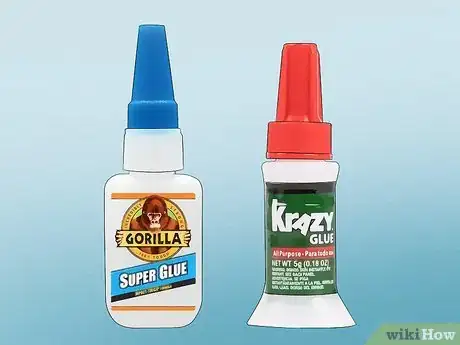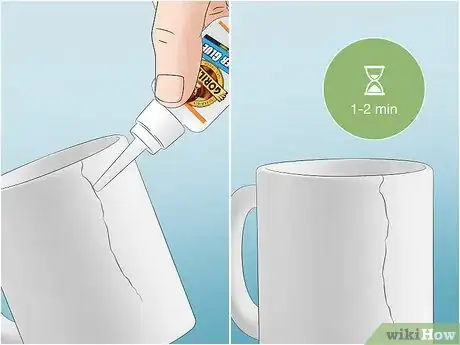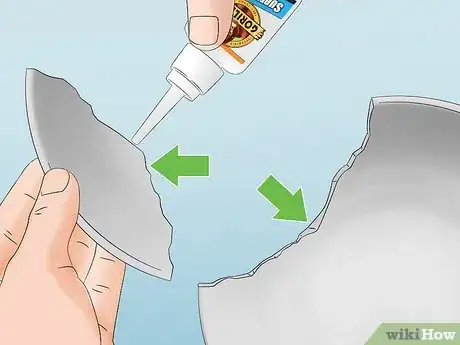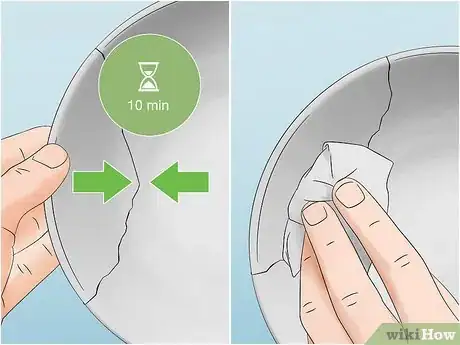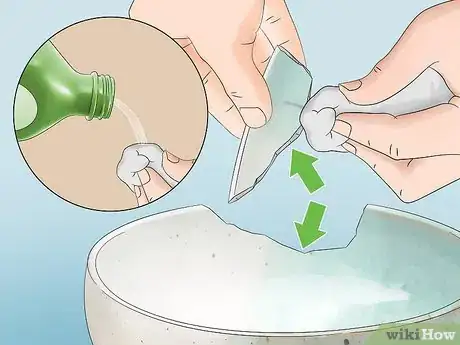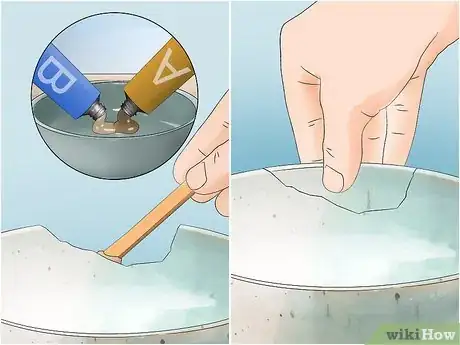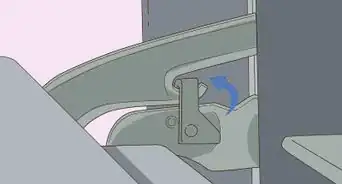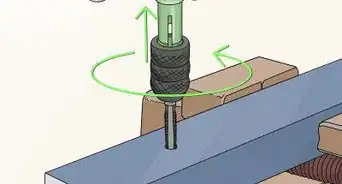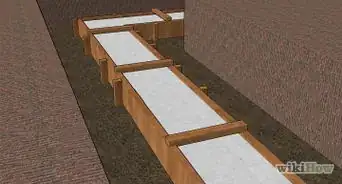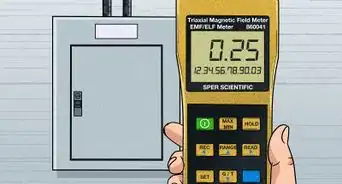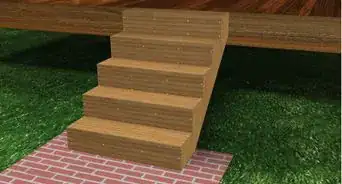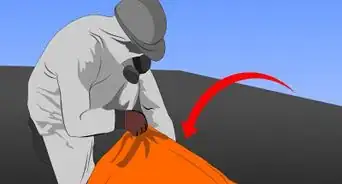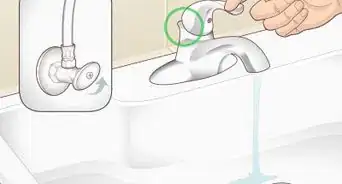This article was co-authored by Natasha Dikareva, MFA. Natasha Dikareva is a San Francisco, California based sculptor, and installation artist. With over 25 years of ceramics, sculpting, and installation experience, Natasha also teaches a ceramic sculpture workshop titled "Adventures in Clay" covering concept development, hand-building techniques, texture, and glazing techniques. Her work has been featured in solo and group exhibitions at the Beatrice Wood Center for the Arts, Abrams Claghorn Gallery, Bloomington Center for the Arts, Maria Kravetz Gallery, and the American Museum of Ceramic Art. She has taught at the University of Minnesota and the American Indian OIC School. She has been awarded the Excellence Award at the 1st World Teapot Competition, Best in Show at the 4th Clay & Glass Biennial Competition, and a Grand Prize at the American Museum of Ceramic Art. Natasha holds an MFA from the University of Minnesota and a BFA from Kiev Fine Arts College.
This article has been viewed 36,328 times.
Have you ever cracked your favorite ceramic mug or piece of pottery? You might be wondering what you can do to fix it. The good news is it’s actually pretty easy to repair cracked or chipped ceramic. You just need to use the right adhesive. To make it easier, we’ve answered some of the most common question that people have about repairing cracked ceramic.[1]
Steps
How do you fix a hairline crack in a ceramic mug?
-
1Apply super glue to the crack and hold it in place for 1-2 minutes. If there’s a small gap in the crack, press both sides together. Use the applicator tip of the super glue to apply the glue directly into the crack. Wait for about 1-2 minutes to allow the glue to soak into the crack and form a bond.[4]
-
2Wipe away the excess glue before it fully dries. Because the hairline crack is so small, it’s likely that you’ll have some excess glue on the surface of the mug. No worries. As soon as you allow the glue to seep into the crack for a minute or so, take a clean cloth and wipe away any excess glue from the surface so it doesn’t have a chance to fully set.[5]
How do you fix a crack in a ceramic bowl?
-
1Apply adhesive to the sides of the crack and press the pieces together. You can use either super glue or a 2-part epoxy. If you choose to use epoxy, make sure you mix both parts together according to the instruction on the packaging. Apply the glue to the edges of the crack and then hold the broken pieces together for a few seconds so the form a bond.[6]
- The adhesive is not fully dry yet, so don’t immediately use the bowl!
-
2Allow the adhesive to dry and then scrape off the excess. Wait about 10 minutes for the adhesive to dry and harden. Then, use a metal scraper or a kitchen knife to scrape off any adhesive that was pushed out of the crack so the surface is nice and smooth.[7]
How do you fix chipped ceramic pottery?
-
1Clean off the pieces with rubbing alcohol. Use rubbing alcohol and a clean cloth to wipe down the pottery. Remove any dust or dirt from the surface and scrub off any old adhesive that may be on the surface so the new adhesive can bond more effectively.[8]
-
2Apply 2-part epoxy to 1 side and hold the pieces together. Mix together 2-part epoxy according to the directions on the packaging and then spread a thin layer on 1 side of the chipped pottery. Then, press the broken piece back into place and hold it for about a minute so it bonds.[9]
- Epoxy is a better choice for chipped pottery because it will fill in the space more effectively than super glue.
-
3Allow the epoxy to cure for an hour and then scrape off the excess. When you press the chipped piece back into place, some of the epoxy may squeeze out between the crack. That’s okay. Allow the epoxy to fully cure and harden and then take a razor blade and scrape off the excess.[10]
Expert Q&A
-
QuestionHow can I repair cracked pottery?
 Natasha Dikareva, MFANatasha Dikareva is a San Francisco, California based sculptor, and installation artist. With over 25 years of ceramics, sculpting, and installation experience, Natasha also teaches a ceramic sculpture workshop titled "Adventures in Clay" covering concept development, hand-building techniques, texture, and glazing techniques. Her work has been featured in solo and group exhibitions at the Beatrice Wood Center for the Arts, Abrams Claghorn Gallery, Bloomington Center for the Arts, Maria Kravetz Gallery, and the American Museum of Ceramic Art. She has taught at the University of Minnesota and the American Indian OIC School. She has been awarded the Excellence Award at the 1st World Teapot Competition, Best in Show at the 4th Clay & Glass Biennial Competition, and a Grand Prize at the American Museum of Ceramic Art. Natasha holds an MFA from the University of Minnesota and a BFA from Kiev Fine Arts College.
Natasha Dikareva, MFANatasha Dikareva is a San Francisco, California based sculptor, and installation artist. With over 25 years of ceramics, sculpting, and installation experience, Natasha also teaches a ceramic sculpture workshop titled "Adventures in Clay" covering concept development, hand-building techniques, texture, and glazing techniques. Her work has been featured in solo and group exhibitions at the Beatrice Wood Center for the Arts, Abrams Claghorn Gallery, Bloomington Center for the Arts, Maria Kravetz Gallery, and the American Museum of Ceramic Art. She has taught at the University of Minnesota and the American Indian OIC School. She has been awarded the Excellence Award at the 1st World Teapot Competition, Best in Show at the 4th Clay & Glass Biennial Competition, and a Grand Prize at the American Museum of Ceramic Art. Natasha holds an MFA from the University of Minnesota and a BFA from Kiev Fine Arts College.
Ceramics & Sculpting Instructor You can fix a crack in pottery in several ways. Use vinegar or buy magic water to repair cracks in a sculpture. Otherwise, make the crack bigger and fill a mixture of the same clay and some particles of fire clay.
You can fix a crack in pottery in several ways. Use vinegar or buy magic water to repair cracks in a sculpture. Otherwise, make the crack bigger and fill a mixture of the same clay and some particles of fire clay. -
QuestionWhat can I use to paint ceramic?
 Natasha Dikareva, MFANatasha Dikareva is a San Francisco, California based sculptor, and installation artist. With over 25 years of ceramics, sculpting, and installation experience, Natasha also teaches a ceramic sculpture workshop titled "Adventures in Clay" covering concept development, hand-building techniques, texture, and glazing techniques. Her work has been featured in solo and group exhibitions at the Beatrice Wood Center for the Arts, Abrams Claghorn Gallery, Bloomington Center for the Arts, Maria Kravetz Gallery, and the American Museum of Ceramic Art. She has taught at the University of Minnesota and the American Indian OIC School. She has been awarded the Excellence Award at the 1st World Teapot Competition, Best in Show at the 4th Clay & Glass Biennial Competition, and a Grand Prize at the American Museum of Ceramic Art. Natasha holds an MFA from the University of Minnesota and a BFA from Kiev Fine Arts College.
Natasha Dikareva, MFANatasha Dikareva is a San Francisco, California based sculptor, and installation artist. With over 25 years of ceramics, sculpting, and installation experience, Natasha also teaches a ceramic sculpture workshop titled "Adventures in Clay" covering concept development, hand-building techniques, texture, and glazing techniques. Her work has been featured in solo and group exhibitions at the Beatrice Wood Center for the Arts, Abrams Claghorn Gallery, Bloomington Center for the Arts, Maria Kravetz Gallery, and the American Museum of Ceramic Art. She has taught at the University of Minnesota and the American Indian OIC School. She has been awarded the Excellence Award at the 1st World Teapot Competition, Best in Show at the 4th Clay & Glass Biennial Competition, and a Grand Prize at the American Museum of Ceramic Art. Natasha holds an MFA from the University of Minnesota and a BFA from Kiev Fine Arts College.
Ceramics & Sculpting Instructor You can use acrylics or oil paint. If you use oil paint, the drying process may be slower.
You can use acrylics or oil paint. If you use oil paint, the drying process may be slower. -
QuestionHow can I transfer images onto ceramic?
 Natasha Dikareva, MFANatasha Dikareva is a San Francisco, California based sculptor, and installation artist. With over 25 years of ceramics, sculpting, and installation experience, Natasha also teaches a ceramic sculpture workshop titled "Adventures in Clay" covering concept development, hand-building techniques, texture, and glazing techniques. Her work has been featured in solo and group exhibitions at the Beatrice Wood Center for the Arts, Abrams Claghorn Gallery, Bloomington Center for the Arts, Maria Kravetz Gallery, and the American Museum of Ceramic Art. She has taught at the University of Minnesota and the American Indian OIC School. She has been awarded the Excellence Award at the 1st World Teapot Competition, Best in Show at the 4th Clay & Glass Biennial Competition, and a Grand Prize at the American Museum of Ceramic Art. Natasha holds an MFA from the University of Minnesota and a BFA from Kiev Fine Arts College.
Natasha Dikareva, MFANatasha Dikareva is a San Francisco, California based sculptor, and installation artist. With over 25 years of ceramics, sculpting, and installation experience, Natasha also teaches a ceramic sculpture workshop titled "Adventures in Clay" covering concept development, hand-building techniques, texture, and glazing techniques. Her work has been featured in solo and group exhibitions at the Beatrice Wood Center for the Arts, Abrams Claghorn Gallery, Bloomington Center for the Arts, Maria Kravetz Gallery, and the American Museum of Ceramic Art. She has taught at the University of Minnesota and the American Indian OIC School. She has been awarded the Excellence Award at the 1st World Teapot Competition, Best in Show at the 4th Clay & Glass Biennial Competition, and a Grand Prize at the American Museum of Ceramic Art. Natasha holds an MFA from the University of Minnesota and a BFA from Kiev Fine Arts College.
Ceramics & Sculpting Instructor You can do screen printing. For this, you need a printer that has iron oxide. You have to fire the piece after using this method. Or you can buy prints known as decals. They do not require firing. You have to put them in water and wait for the printed image to separate from the paper. Then you apply it to the piece. You should do this carefully and remove all the air bubbles from underneath.
You can do screen printing. For this, you need a printer that has iron oxide. You have to fire the piece after using this method. Or you can buy prints known as decals. They do not require firing. You have to put them in water and wait for the printed image to separate from the paper. Then you apply it to the piece. You should do this carefully and remove all the air bubbles from underneath.
Warnings
- Don’t try to use craft glue or other types of glue to fix ceramic because it may not be strong enough to repair it and it may contain toxic chemicals.⧼thumbs_response⧽
References
- ↑ Natasha Dikareva, MFA. Ceramics & Sculpting Instructor. Expert Interview. 5 May 2020.
- ↑ https://www.bobvila.com/articles/best-glue-for-ceramic/
- ↑ https://www.bobvila.com/articles/best-glue-for-ceramic/
- ↑ https://coffeecherish.com/how-to-repair-hairline-crack-in-coffee-mug/
- ↑ https://coffeecherish.com/how-to-repair-hairline-crack-in-coffee-mug/
- ↑ https://youtu.be/oMyx4PqBLJQ?t=171
- ↑ https://youtu.be/oMyx4PqBLJQ?t=258
- ↑ http://www.lakesidepottery.com/Pages/Pottery-tips/How-to-fix-broken-pottery-china-ceramic-lesson-1.htm
- ↑ http://www.lakesidepottery.com/Pages/Pottery-tips/How-to-fix-broken-pottery-china-ceramic-lesson-1.htm


